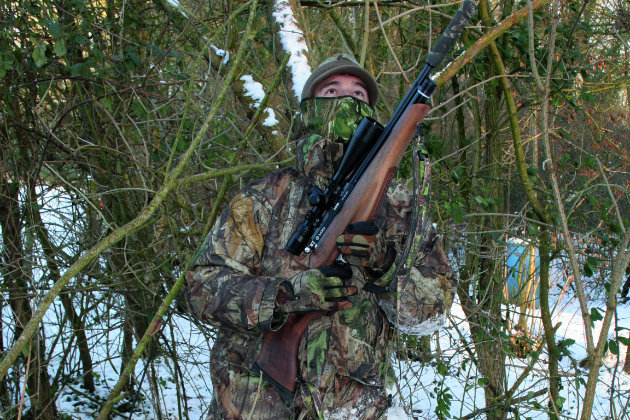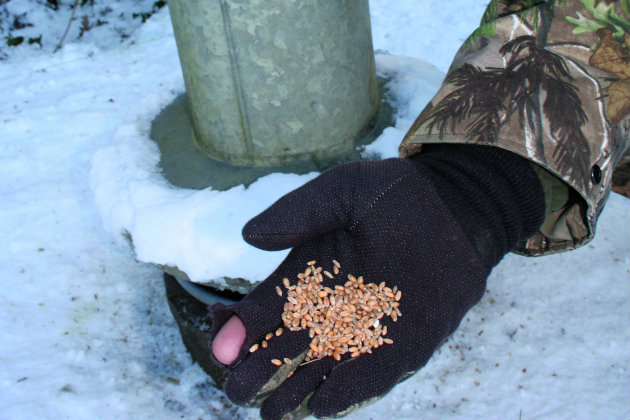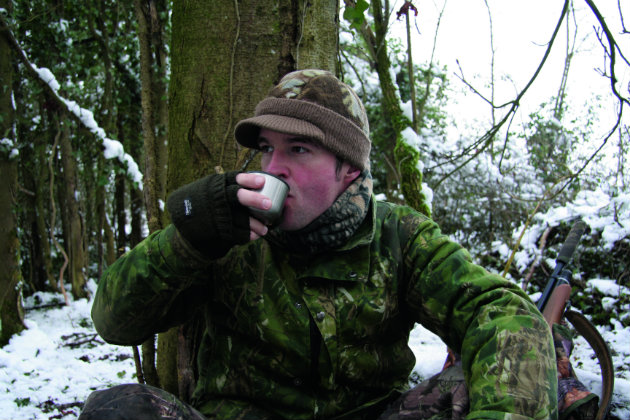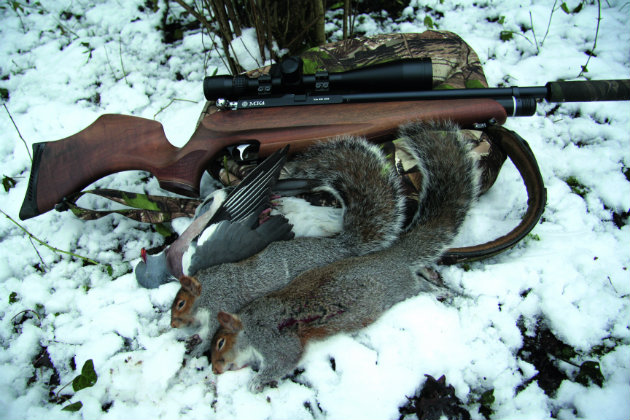Will I need to heat my shotgun cabinets in winter?
I have recently applied for a shotgun certificate, and my preferred place in which to put my shotgun cabinets is…
Win CENS ProFlex DX5 earplugs worth £1,149 – enter here

It might be cold out there but many of the pest species we can control with airguns are much easier to pinpoint during the winter – so airgunning in the cold will probably bring the results you are looking for.
Dress warmly, take the right kit and you’ll have a useful outing.
Most of my winter pest control with air rifles revolves around shooting grey squirrels. It’s much easier to pinpoint these greedy rodents when the mercury falls below zero and frosts and blustery winds have stripped away foliage to leave the branches bare.

Putting grain into a feeding station will lure in grey squirrels, corvids and rats when food is scarce
In addition, natural food in the form of beechmast, sweet chestnuts and acorns is running low, and the squirrel will find it hard to unearth its stash from frozen ground. For this reason, man-made food sources such as pheasant feeders act like magnets to squirrels when times are tough — you can also expect to find rats, corvids and even woodpigeon plundering grain put out by the gamekeeper.
If you don’t share your ground with a pheasant shoot, you can create your own feeding station by putting out a hopper loaded with corn or peanuts — hungry squirrels will home in on it in no time.
Wild creatures that feed by daylight have a much smaller window of opportunity to feed up in readiness for the long, cold night that awaits them when it’s only light for about eight hours.
Expect feeding stations to receive a steady trickle of visitors throughout the day, with a distinct spike at first light when they emerge ravenous from their slumber, and again just before dusk when they fuel up for the coming night. These two prime times can make for very productive shooting if you set up an ambush next to a feeder.
I have recently applied for a shotgun certificate, and my preferred place in which to put my shotgun cabinets is…
When pigeon shooting in winter, is it best going out at first light for decoying over rape – or is…
Most winter airgun shooting is best done from a static position as you stake out a known location, so you need to rely on your clothing to seal in the warmth. The limited power of airguns means you need to hunt at relatively close range — even when I’m using an FAC-rated air rifle, I prefer to get within 40m if I can. Closing in on wary quarry is tricky at the best of times, and can seem almost impossible when every footstep hits the ground with a “whump”. With that in mind, I tend to give up on stalking if the ground is covered in snow or encrusted in a hard frost. Wrapping up warm and sitting it out tends to give better results.
Layering is the key to good temperature management. I always wear a long-sleeved bamboo-fibre vest, long-sleeved shirt and lightweight fleece beneath my shooting jacket when heading out in the cold. I’ll add another fleece if there’s a really chilly wind blasting in. A pair of quilted trousers is a great addition to your winter wardrobe, and will certainly help to keep you toasty. I also wear two thick pairs of socks as standard, and will even slip hand-warmer pads into my boots if I’m planning to spend long periods sitting still in extreme cold.
Fingers are just as vulnerable as toes. Neoprene gloves are great for most winter shooting, but I’ll opt for chunky mittens on days when the temperature is unlikely to rise above zero. Gloves with fold-back fingers are really handy, as you don’t need to take them right off for fiddly jobs such as reloading and touching off the trigger.
On your head wear something made from from wool or fleece, because keeping your head and ears warm makes a huge difference when trying to stay comfortable in wintry weather. It’s also worth wearing a scarf or snood to insulate the gap around your collar, and you can pull it over your face if there’s an icy blast.
Personally I don’t find specialist snow camouflage patterns necessary because even after snowfall, there’s usually enough vegetation for traditional camo to blend in.
You will soon become uncomfortable if you sit with your backside on frozen earth so you need some insulation.
I use a beanbag seat, which not only provides a stable, comfortable shooting platform, but also does a great job of sealing out the cold thanks to its filling of polystyrene balls that are pumped into cavity walls to insulate buildings.

A hot drink will raise your spirits as well as your temperature
I’ve already mentioned how hand- warmer pads can be inserted into your boots to keep your feet comfortable, and it’s worth keeping a pack or two in your kitbag. Inexpensive, compact and lightweight, these pads heat up in seconds and provide hours of heat if you need to warm up your fingers or toes.
A hot drink has to be my all-time essential when it comes to effective winter warmers, as it gives heat and sustenance. Pour a mug of piping-hot tea or coffee from a flask and it’ll raise your spirits as well as your temperature when the cold sets in. I often take an extra one loaded with soup for long sessions.

Adding a couple of grey squirrels – notorious winter marauders – to your bag is immensely satisfying
Don’t forget your mobile so you raise the alarm if you get into difficulty.
It’s foolish to take unnecessary risks, and I’d advise cancelling a shooting trip when perilously harsh weather is forecast, but accidents such as slips and falls can happen at any time, so it’s always wise to take proper precautions.
It’s important to remember that most airgunners have a job to do. By and large, we secure our shooting permissions by offering a pest control service to farmers and gamekeepers. The arrangement should be mutually beneficial: we get a place to enjoy our sport and our host receives some welcome help with the ongoing effort to keep pests in check.
However, this agreement means we need to toe the line and show willing whatever the weather. It’s easy to fall for the creature comforts of home when it’s cold or wet outside, but don’t expect your host to be sympathetic. They probably don’t have the luxury of being able to pick and choose when they do their outdoor work and are likely to expect you to show the same commitment to your duties around the farm, fields or woods. Allow your pest control rounds to slip and you can rest assured that some other keen shooter eager to secure a new permission will jump in there.
Get the latest news delivered direct to your door
Discover the ultimate companion for field sports enthusiasts with Shooting Times & Country Magazine, the UK’s leading weekly publication that has been at the forefront of shooting culture since 1882. Subscribers gain access to expert tips, comprehensive gear reviews, seasonal advice and a vibrant community of like-minded shooters.
Save on shop price when you subscribe with weekly issues featuring in-depth articles on gundog training, exclusive member offers and access to the digital back issue library. A Shooting Times & Country subscription is more than a magazine, don’t just read about the countryside; immerse yourself in its most authoritative and engaging publication.

